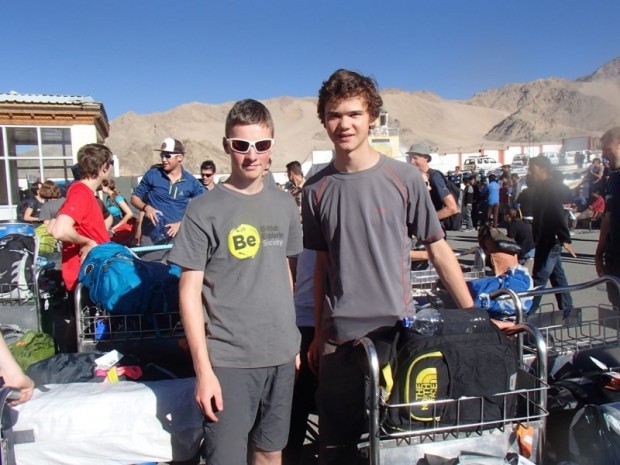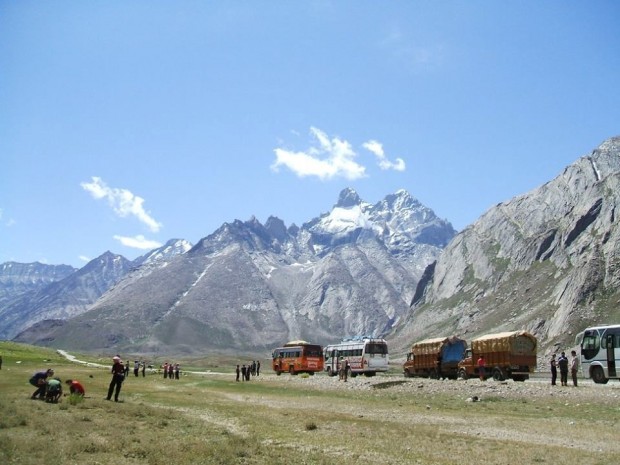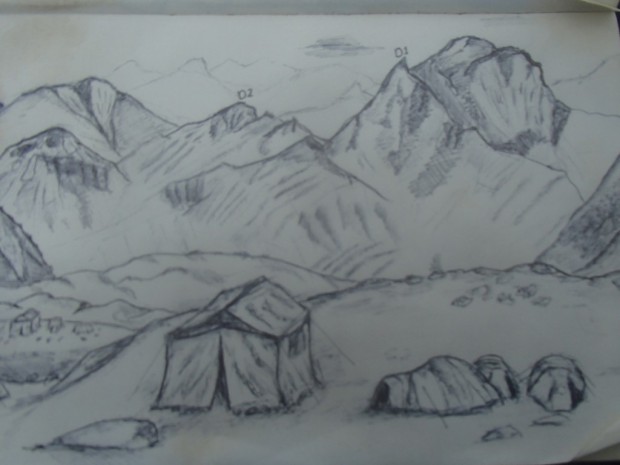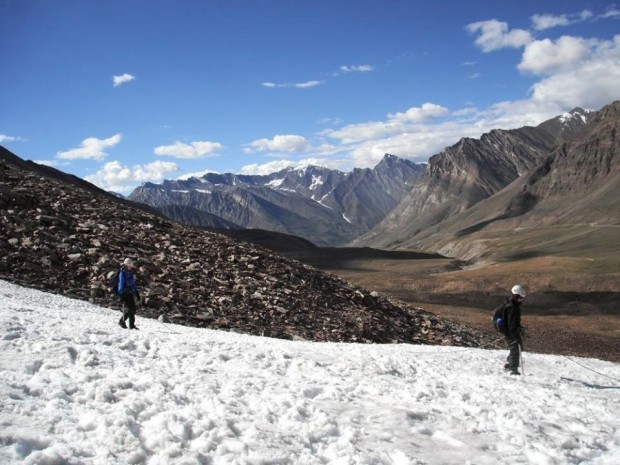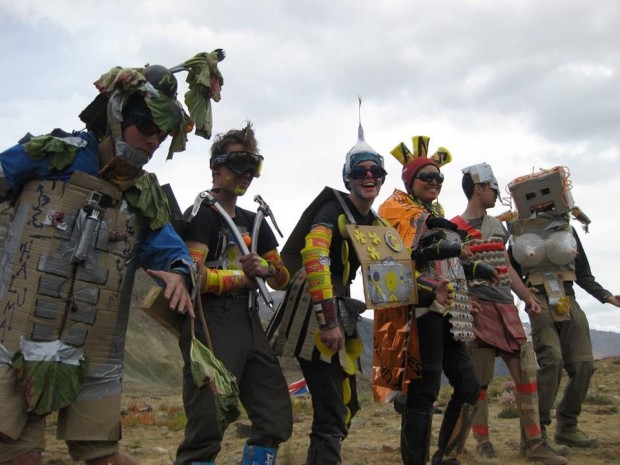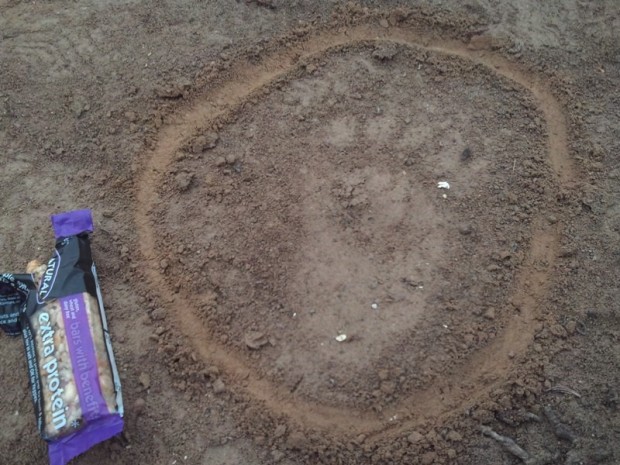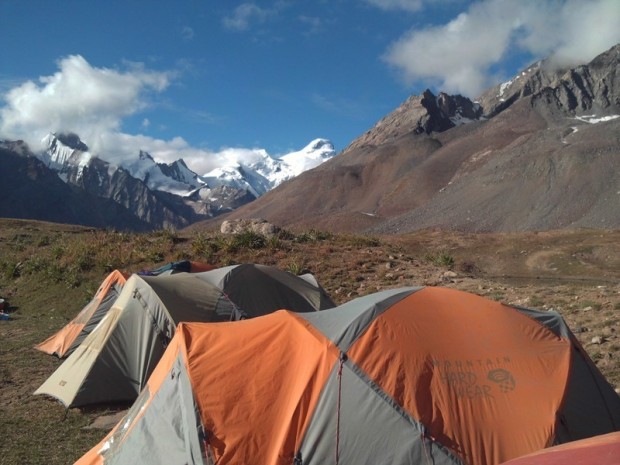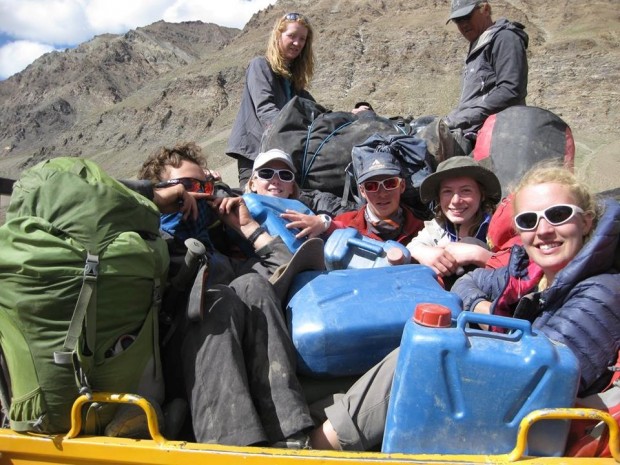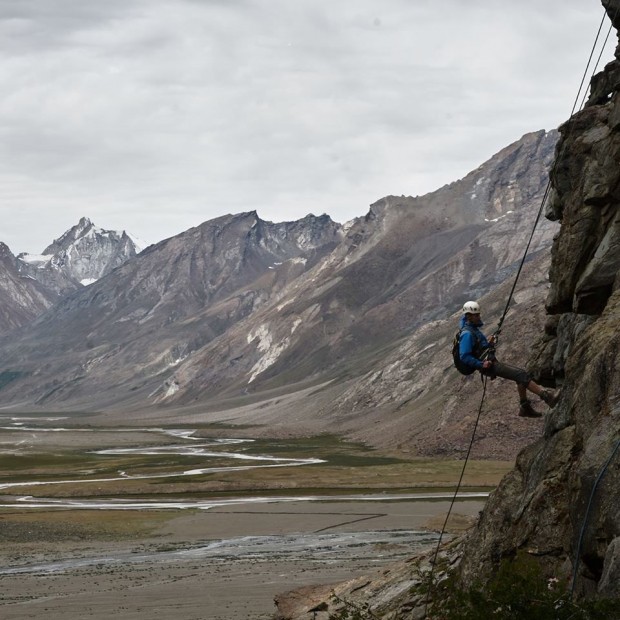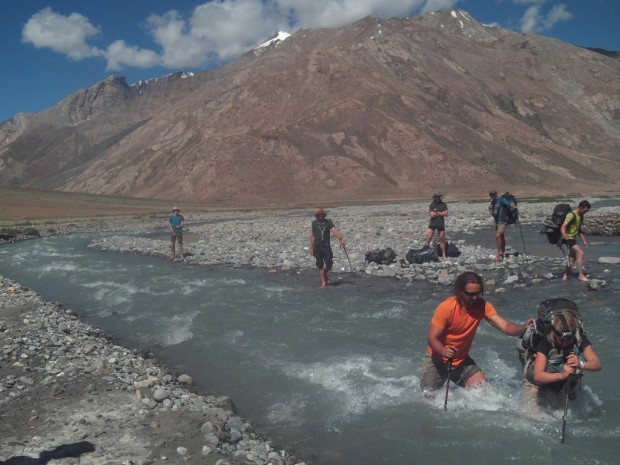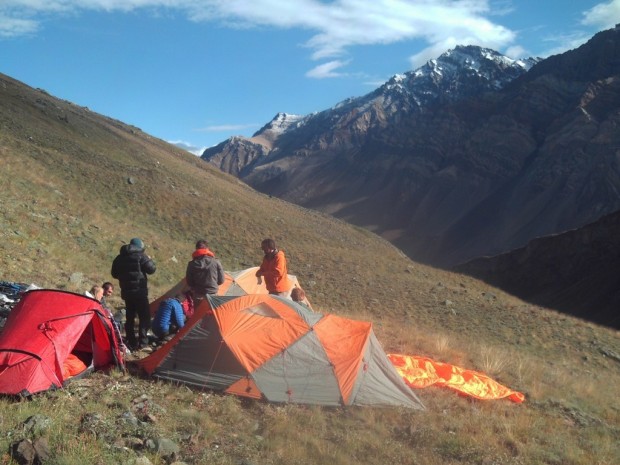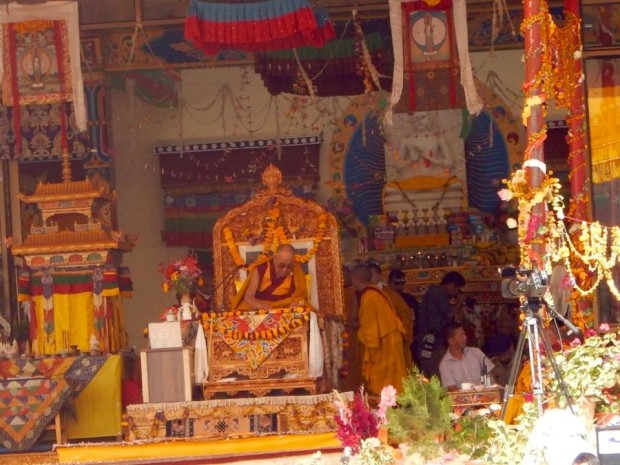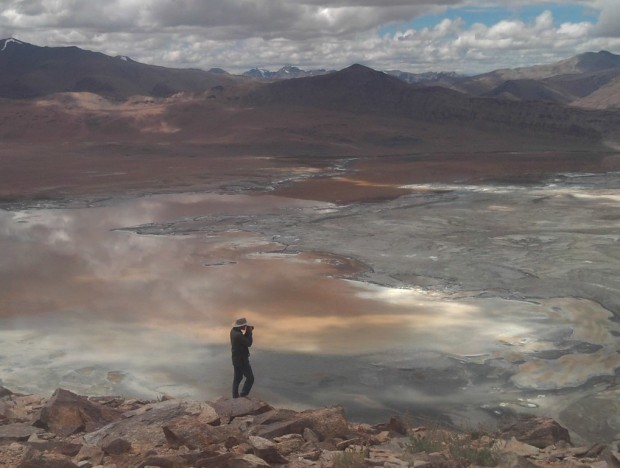Report by Calum Kitching
Recipient of the Sir Vivian Fuchs Award
The Himalayas is somewhere which I’ve always thought looked amazing. It fits into everything which inspires me, travelling, mountains, climbing, geography and mountaineering. When I first heard about BES and their expeditions I was hooked. The Amazon, Namibia or Iceland weren’t really up my street but the Indian Himalayas definitely was. After being accepted onto the expedition I set about fundraising. I had a stall at a Christmas fair and my largest fundraiser was a Ceilidh where I made £1,200 in one night. I wrote lots of letters and raised over £2,000 in grants, even receiving £50 from my MP out of the blue. This set me up perfectly to have an adventure in the largest mountain range on earth.
I left for Heathrow on the 22nd of July from Aberdeen. The rest of the expedition group were already waiting in a (very hard to find) corner of Heathrow airport and there was a very excited buzz around everyone. It must have been a funny sight with 50 of us hauling all sorts of strange looking pieces of group kit through check-in. Safe to say everything went (fairly) smoothly and soon I was sitting on the Jet Airways Boeing 747 Delhi bound.
I don’t sleep on planes which was inconvenient on a 9-hour overnight flight, luckily lots of films provided enough entertainment to get me to Delhi – a time zone 4.5 hours ahead. After a very humid and unpleasant night in Delhi we left for Leh at 2am (yes really!) the next morning. The views flying in were stunning and clear flying over snowy peaks and glaciers really got the excitement flowing. The air in Leh – Ladakh’s largest town – was noticeably thin but flying straight up to 3,400m above sea level was always going to be a shock to the system. Even walking the 5 steps up to our cramped room in the hostel where we all slept left you panting for air.
The next few days consisted of exploring Leh and enjoying its various markets and shops all as part of the acclimatising to the altitude phase. During these few days we were joined by the other half of our expedition, the 3 weekers who, as the name suggests, were only there for 3 weeks as opposed to our 5. This brought our numbers up to around 90 people including leaders, medics and trainee leaders. In this phase we also undertook basic training in steep ground walking, rope work, the risks of altitude and most importantly hygiene. Hygiene played a large role in the expedition as if done incorrectly can make or break an expedition, especially in a large group like ours.
A few days later we set off on 4 long days of travelling in coaches towards what would be our base camp. Here we got our first experience of Indian roads – cars driving on the wrong side of the road, precarious exposed mountain roads and pot holes and bumps which had us hitting our heads off the ceiling. We also experienced the Indian army’s large presence in Ladakh at the endless checkpoints. The political situation in Ladakh means that it is highly disputed between India, China in the East and Pakistan in the West so the army were obviously twitchy. On one day we were held up at a checkpoint at a small village called Rangdum for nearly 5 hours. This disrupted our travelling day meaning we didn’t reach our planned campsite for the night and ended up camping in a local’s garden.
Our base camp was situated at Pensi La at a height of 4,400m and overlooked the stunning DrangDrung glacier and the Zanskar valley. It was surrounded by lots of small lakes (‘Kettle holes’ in geographical terms) separated by large moraine ridges. As someone who is interested in glaciers and glaciation I found it a very interesting and complex landscape. Although pretty to look at, the large moraine ridges were unwelcome when we had to carry large amounts of personal and group kit 500m from the road to our base camp site. This may not sound like a long way but at 4,400m there is almost half the amount of oxygen there is at sea level making progress very slow and arduous.
Our first few days at base camp were filled with another set of training, this time in mountain skills such as walking on boulder fields and a very exciting day learning snow skills on a snow patch above base camp. This involved learning to walk with crampons and use ice axes but the best bit was doing ice axe arrests where we slid downhill on our stomachs or backs or headfirst and had to bring ourselves to a stop using a very specific technique called jamming. This was a long day with at least 7 hours on the ice and a 9-hour round day. The next day I was hit by back pains presumably from lots of odd movement patterns on the ice. This meant I had to stay at base camp while the rest of my fire headed off on our first excursion. This was very disappointing however they were hit by an electrical storm and forced to abandon on the first day in the pouring rain. They arrived back at 10pm completely sodden and in low spirits but the whole camped chipped in to dry them off, warm them up and put up their tents.
Our next fire trip out of base camp was 2 hours walking down the valley where we set up some top-rope climbing on some lovely crags. Our fire leader Taff was an expert climber and made a point of ‘showing us the ropes’ as it were. We had 5 different climbs and had a really great couple of days of climbing. I even managed to get in a night climb with a head torch which was a new experience. The following day on returning to base camp we heard that one of the trainee leaders (TL) had fallen very ill with High Altitude Cerebral Oedema while out on the Drang Drung glacier roughly 10 kilometres away from base camp. He needed to be evacuated so two Indian military helicopters where sent to evacuate him. He was flown back down to Leh then back to London. Luckily I hear he made a full recovery but it was a shock to lose one of our party.
On the final day at base camp for the 3 week explorers we held our own Olympics (some compensation for missing the real thing I guess). Although this was rather unconventional and there was certainly no 10,000m or swimming due to the altitude. The first task was to build a robot – yes really! We made our one out of cardboard from around camp, duck-tape and for some strange reason rhubarb. It was certainly a good show of recycling. I was lucky enough to be our candidate and fair to say I looked ridiculous. With our robot we ‘competed’ in a fashion show, obstacle course and blindfolded challenge where I’m not too sure what happen because…well…I was blindfolded. That evening each fire was given a feast. This consisted of rice and hydrated curry mixes. This may not sound much but compared to the ration packs we had been eating it was lovely. To be honest the worst part of the expedition lay in the food. I found the ration packs really quite grim as well as the noodle pots we had for lunch which after a couple weeks really began to disagree with me. Every morning we had porridge which was bearable but did need sprucing up with honey, hot chocolate or raisins especially after several weeks.
Our luck was worsened a few days later when a bear visited our camp, which played a big role in shaping the second half of the expedition for us 5 week explorers. We were woken at 11pm by our chief Leader Bruce shouting “Everyone out of your tents, everyone down to the basecamp as fast as possible.” I didn’t need any telling to move quicker as I was out of my tent in a shot, no time to get dressed. Running down to the main base camp I saw the bear on the hillside above one of the other camps, completely un-phased by the many people banging ice axes together and making noise to try and scare it. It was a sight to behold. I later heard it was a Himalayan Brown bear. We were ushered into a large kit tent and were soon joined by around 30 other people from different fires. After everyone had calmed down we were instructed to try and get some sleep. This was frankly impossible and to no exaggeration it was the most uncomfortable night of my life. Our Leaders and TL’s kept a watch through the night, luckily it didn’t come near the main camp but instead raided our smaller fire camps.
The next morning we were woken (which is a loose term as I swear I didn’t sleep) at 5:30am and trudged back to our fire camp – or ‘Haluma HQ’ as it was called. We were shocked to see what state it was in. The bear had taken a fancy to our camp over anyone else’s. All the food, rubbish and equipment from our group tent was strewn around our camp. The bear had ripped into the tent and broken into any food it could get its paws on. It had taken a particular fancy to our dehydrated ration packs and had munched through nearly 40 of them – a very dehydrated bear I’m sure. Luckily it had left our sleeping tents alone. Spirits were very low as our exhausted and cold fire set about fixing things up. We had to decontaminate anything the bear had touched which involved soaking everything in big bowls of sterilised water. It was a long and tedious process. The order then came through that our whole party would have to move our entire base camp about 1km to the south, further away from the bear area before moving even further the next day. This involved packing up everything and shuttling it across over round and hill ground. This was arguably one of the most physically demanding days of the expedition. Carrying heavy load after heavy load for several hours was bad enough but something I found was that the altitude hit so much harder when tired. The next day we packed up our tents again and headed by truck 20 kilometres down the valley to Rangdum, a very small little village with very friendly local people who had obviously seen very few westerners.
The next couple of days comprised of setting up another base camp or ‘Base camp mark 2’ – something we had become quite good at. From our new location we had the opportunity to explore a new landscape. One of my best memories from this area was a 2 day trek up a couple of valleys to recce them for other groups. This was done by a small but elite group of us and the pace was certainly fast. I also got to experience my first river crossing which was amazing but equally chilling. As someone who enjoys trekking and pushing myself this was a great few days. Another excursion we did from Rangdum was a day of climbing and abseiling on crags above our base camp.The crag overlooked the valley so the views were very picturesque. Climbing is something I really enjoy so found this one of the highlights of our time in Rangdum. The low point of our time in Rangdum later that day when we were told we would be returning to Leh prematurely. This was again due to the bear threat and the BES council back in London were enforcing the protocol that we had to be at least 100km away from a bear inhabited area. This was highly disappointing and I was gutted to be leaving the high mountains behind, however I realise that BES really had no choice and had their hands tied by safety concerns. I must stress again how well the leading team dealt with another unplanned change to the expedition schedule.
We arrived back in Leh on the 18th of August and we took a couple days to set plans for the final excursion of the expedition. In this time we visited a couple of monasteries around Leh. It just so happened that the Dalai Lama himself was speaking at his summer palace just outside of Leh. We had the amazing experience of going to watch him talk and see him in person. Although I couldn’t understand what he was saying the atmosphere was amazing. We were also handed bracelets which had been blessed by the Dalai Lama. This was the most culturally interesting and amazing thing we did and it also makes a great story.
For the final excursion there were two options. Firstly there was the option to go to some lakes roughly 50km to the south where there would be ecological science work and some short walks. The second option was to attempt a 5900m high peak involving some glacier walking and rope work. This really excited me so I jumped at the opportunity. I had all my bags and equipment packed but was hit by a nasty stomach bug the night before going. I could not believe how unlucky I had been with the timing and instead of heading off to the mountain was confined to my sleeping bag in the hostel for a couple of days. This was so disappointing for me especially when I heard that a good number of them had reached the 5910m high peak. My luck did pick up a bit when one of the expedition medic allowed myself and a couple of others to head over to join the group a the lake for the final 2 days. Despite still feeling under the weather I did enjoy it especially getting a day out to head up a peak and reach my high point of the five weeks at 5210m above sea level. The view from the peak was amazing as it overlooked the salt lakes below. The day was finished off with eating nutella pancakes while watching the incredible combination of perfect light and hanging rain clouds across the other side of the valley. The journey back to Leh involved heading over the Taglang pass (5359m) which is one of the highest motor-able passes in the world.
The expedition was rounded off with two days in Leh before flying out. We spent this time buying souvenirs in the ridiculously cheap shops, although some firm haggling was needed to avoid being ripped off. In our hostel I got talking to a Hungarian ultra runner who was there for the Ladakh marathon and we planned to go running around the streets of Leh. I had been keen to do this since arriving in Ladakh and fair to say it was a great experience. However running at altitude is hard work, especially running up a long staircase to a hilltop monastery but the views over Leh were amazing.
On our final night we had a whole expedition meal out at a restaurant in Leh. This was a nice time to reflect on the expedition and have a laugh with everyone. Gift were also handed out to our expedition leaders Nige and Bruce although Bruce was too tall for the trousers but Nige was so proud of his knitted shoes he wore them on the plane the next day.
Travelling home was a long day which started at 3am in our hostel before heading down to the airport in taxi’s. Leh airport is certainly an experience. The security is quite hit and miss with them checking some baggage for 20 minutes and not checking some at all. It took a long time to get our whole party through but soon after we were back on the airport tarmac on our flight to Delhi. After a rather drawn out connection in Delhi we were finally heading home on the 9 hour flight to Heathrow. In booking flights to get back to Aberdeen from Heathrow I had overlooked the fact that 1h 40m was in fact not very long to get from coming off one flight to checking into another. This was made more stressful when our bags took almost an hour to come off the plane. After grabbing my bag and saying a brief goodbye to my fire I had to rush towards the bus station to change terminals. I found what I thought was the right bus but when it came along was told it did in fact not go to terminal 5 and was pointed in direction of another bus. However the other bus driver gave me a puzzled look when I asked if he went to terminal 5 and pointed at the bus I had just been to saying it was that one, which, by that time was pulling off. Oh dear. With 15 minutes to make my check in I very politely jumped to the front of the taxi queue and waited. Eventually one came along but the driver was convinced he would not be able to get me there in time. I was dreading a night sleeping on a Heathrow bench so threw £20 at him just to try. In my good fortune the roads were clear so I dived out of the taxi 10 minutes later and somewhat sprinted to the check-in arriving less than 2 minutes before it closed. That caused me to breath a rather large sigh of relief and meant I managed to get on my flight home to Aberdeen. It was great to see my family again and indulge in the luxury of home.
In the few days after coming home, even in the small spaces of free time I didn’t know what to do with myself. I attribute this to the expedition being so full on, always having something to do and always being surrounded by people. However I was happy to drop some of the habits I’d acquired over the past weeks. For example I managed to control the urge to get up in the middle of night and dig a latrine at the bottom of the garden and failed to whip out my primus stove in the school dining hall to boil some water.
Writing this a few weeks later I definitely look back on the expedition as an amazing experience. The way I see it is that the many setbacks we had were all part of the adventure and although they were disappointing at times it has taught me to get up and make the best of the moment. Other hard times like walking into horizontal rain on a mountain side for much of the day has added to my resilience in hard situations. I would not necessarily describe myself as a very sociable person so I didn’t know how interacting with new people and living with the same people in close quarters would affect me. I will not lie, over a 5 week period there were always going to be frustrations within a group and people who get on your nerves, but I think this has allowed me to be more accepting of other people in order to make life manageable in such close proximity to people. The expedition has also made me considerably more independent. This would not have had such a bearing on the older members of the expedition but since I was one of the youngest there was certainly a lot to learn. Being one of the youngest was nice as you got to spend time with an people of an age I rarely get to speak to and many of them had great stories to tell. But it also made it hard at times as it felt like I wasn’t quite able to relate to some people. Spending time with these people has also sparked lots of ideas for travelling and mountain adventures in the future, not least a desire to go back to the Himalayas some day. This experience has confirmed that I definitely want to study Geography at university and want to have a job which involves being in the outdoors. I’m currently applying to Sterling University to study Geography and possibly Outdoor Education and know that my BES experience will support my application.
A huge thank you to all my supporters and sponsors who made this all possible!


